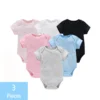Burping is often considered an essential part of feeding a baby, helping to release any air swallowed during feeding and prevent discomfort. However, sometimes, despite your best efforts, your baby might not burp after a feeding session.
This can leave many parents wondering, “What if my baby doesn’t burp after feeding?” While it can be concerning, it’s not always a cause for alarm. Understanding the reasons behind it and knowing when and how to help your baby burp can ease your worries and ensure your baby’s comfort.
In this blog, we’ll explore why some babies don’t burp after feeding, the potential effects, and practical tips to encourage burping and ensure a smoother feeding experience for you and your little one.
What If My Baby Doesn’t Burp After Feeding?
If your baby doesn’t burp after feeding, it may be due to swallowing less air, their position during feeding, or their digestion process. To help your baby burp, try different burping positions, gently pat their back, and keep them upright after feeding. If your baby shows signs of discomfort, it’s essential to consult your pediatrician for further guidance.
Why Some Babies Don’t Burp After Feeding
Understanding why some babies don’t burp after feeding can ease parental worries. One primary reason is that some babies naturally swallow less air during feedings, reducing the need for burping. This can be more common in breastfed babies than bottle-fed ones, as the latch and flow from the breast may lead to less air intake.
Another factor is the baby’s position during feeding. If the baby is fed in a more upright position, there might be less air trapped in its stomach, making burping less necessary. Additionally, each baby has a unique digestion process. Some babies digest food more easily and do not need to burp as frequently.
It’s also possible that the baby burped quietly or that the gas moved through its digestive system without causing discomfort. Observing your baby’s comfort and looking for signs of gas or discomfort can provide clues as to whether a missed burp is a concern.
While burping is essential, it’s not always critical if the baby seems comfortable and shows no signs of distress. It’s essential to monitor your baby’s cues and adjust your approach to feeding and burping based on their needs.
Techniques to Help Your Baby Burp
Ensuring your baby burps after feeding can prevent discomfort and reduce the chances of gas buildup. Here are some effective techniques to help your baby burp:
Different Burping Positions:
Trying different burping positions can make a significant difference. The classic over-the-shoulder position is effective for many babies. Gently holding your baby upright against your shoulder and patting their back can help release trapped air. Another position is sitting your baby on your lap, supporting their chest and head with one hand while patting their back with the other.
Gentle Patting and Rubbing:
In addition to patting, gentle rubbing can help. Circular motions on your baby’s back, combined with gentle pats, can assist in bringing up the burp. Make sure your motions are gentle to avoid startling your baby.
Keeping Baby Upright:
After feeding, keep your baby upright for about 10-15 minutes. This position helps the air to rise and makes burping easier. You can hold your baby upright against your chest or place them in a baby seat.
Burping Breaks During Feeding:
Taking breaks during feeding to burp your baby can prevent discomfort. Pausing after every few ounces of milk or after switching breasts can help manage the air intake and make burping easier.
Observing Baby’s Cues:
Watch for signs your baby needs to burp, such as squirming, fussiness, or pulling away from the bottle or breast. Responding promptly to these cues can help prevent discomfort from trapped gas.
Utilizing these techniques can help your baby burp more effectively, ensuring they remain comfortable and reducing the chances of gas-related fussiness. Adjusting your approach based on your baby’s needs and cues will make feeding and burping smoother for both of you.
Practical Tips to Ensure Effective Burping
Burping your baby effectively can help reduce discomfort and prevent gas buildup. Here are some practical tips to ensure effective burping:
- Try Different Burping Positions: Experiment with various burping positions to find what works best for your baby:
- Over-the-Shoulder: Hold your baby upright against your shoulder and gently pat or rub their back.
- Sitting Up: Sit your baby on your lap, supporting their chest and head with one hand while patting their back.
- Face Down on Your Lap: Lay your baby face down across your lap, supporting their head slightly higher than their chest, and gently pat their back.
- Use Gentle Patting and Rubbing: In addition to patting, try gently rubbing your baby’s back in circular motions. Combining gentle pats with circular rubs can help release trapped air more effectively. Always ensure your motions are gentle to avoid startling your baby.
- Keep Baby Upright After Feeding: Hold your baby upright for about 10-15 minutes after feeding. This position helps the air to rise, making burping easier. You can hold your baby upright against your chest or place them in a baby seat to help keep them in an upright position.
- Take Burping Breaks During Feeding: Pause feeding to burp your baby after every few ounces of milk or after switching breasts. These breaks can help manage air intake and prevent discomfort. Burping during feeding can help reduce the amount of air swallowed and ensure your baby is more comfortable.
- Observe Baby’s Cues: Pay attention to signs that your baby needs to burp, such as squirming, fussiness, or pulling away from the bottle or breast. Responding promptly to these cues can help prevent discomfort from trapped gas and ensure your baby is more comfortable.
- Use a Firm Hand: When burping your baby, use a firm but gentle hand. Light taps may not be effective, so make sure your pats are strong enough to help release the trapped air but not so hard that they cause discomfort.
- Massage Baby’s Tummy: If your baby is still having trouble burping, try gently massaging their tummy. Rubbing your baby’s abdomen in a circular motion to help move the trapped air. This can be particularly effective if combined with other burping techniques.
- Be Patient: Sometimes, burping can take a little time. Be patient and give your baby a few minutes in each burping position to allow the air to rise and be released. Patience can often be key to successful burping.
Following these practical tips can help ensure effective burping and reduce your baby’s discomfort from trapped gas. Adjusting your approach based on your baby’s needs and cues will make feeding and burping smoother for both of you.
What Are the Signs of Gas Discomfort in Babies?
Gas discomfort can cause significant distress for babies and can be challenging for parents to manage. Recognizing the signs of gas discomfort can help you take steps to alleviate your baby’s discomfort. Here are some common indicators:
- Fussiness and Crying Babies experiencing gas discomfort often become fussy and may cry inconsolably. This crying is usually more intense and prolonged than normal fussiness, and it may occur suddenly, especially after feeding.
- Pulling Legs Up One of the classic signs of gas discomfort is when babies pull their legs up toward their abdomen. This position can help relieve some of the pressure and pain caused by gas.
- Squirming and Arching Back Gas can make babies feel uncomfortable, leading them to squirm, twist, or arch their backs. These movements are attempts to find a more comfortable position or to help expel the trapped gas.
- Tummy Bloating A swollen or bloated tummy can be a visible sign of gas buildup. If your baby’s abdomen feels hard or looks distended, it could be due to trapped gas.
- Difficulty Sleeping Gas discomfort can interfere with your baby’s ability to sleep. Gas could be the culprit if your baby has trouble settling down or wakes up frequently and seems uncomfortable.
- Refusal to Eat A baby experiencing gas discomfort might refuse to eat or have difficulty feeding. They may start feeding but then pull away, cry, or act unsettled because the gas makes feeding uncomfortable.
- Grunting or Straining Grunting, straining, or making faces as if trying to pass gas or stool are common behaviors in babies with gas discomfort. These actions are their way of trying to relieve the pressure.
- Spitting Up While spitting up is common in many babies, frequent or forceful spitting up can be a sign of gas discomfort, especially if it is accompanied by other symptoms like fussiness or tummy bloating.
By being aware of these signs, you can better understand when your baby is experiencing gas discomfort and alleviate it, such as burping them more frequently, adjusting their feeding position, or using gentle tummy massages. If gas discomfort persists or worsens, consult your pediatrician for further guidance and support.
Step-by-Step Guide to Help Your Baby Burp
Helping your baby burp effectively can prevent discomfort and reduce gas buildup. Here’s a detailed step-by-step guide to ensure your baby burps successfully:
1. Choose a Comfortable Position
- Over-the-Shoulder: Hold your baby upright against your shoulder with their chin resting on your shoulder. Support their bottom with one hand and gently pat or rub their back with the other.
- Sitting Up: Sit your baby on your lap facing away from you. Support their chest and head with one hand, keeping their chin slightly tilted forward. Use your other hand to pat or rub their back.
- Face Down on Your Lap: Lay your baby face down across your lap, with their head slightly elevated above their chest. Support their head with one hand and gently pat or rub their back with the other.
2. Use Gentle Patting and Rubbing
Start by gently patting your baby’s back with a cupped hand. This motion helps to create gentle pressure that can release trapped air. If patting alone isn’t effective, try rubbing your baby’s back in a circular motion. Combining patting and rubbing can often help release the burp.
3. Take Burping Breaks During Feeding
Pause feeding every few ounces or after switching breasts to burp your baby. This can prevent too much air from building up and causing discomfort. Hold your baby in one of the burping positions and gently pat or rub their back for a few minutes before resuming feeding.
4. Keep Baby Upright After Feeding
Hold your baby upright for about 10-15 minutes after feeding. This position helps the air to rise, making it easier for your baby to burp. You can hold your baby against your chest or place them in a baby seat to help keep them upright.
5. Observe Baby’s Cues
Watch for signs that your baby needs to burp, such as squirming, fussiness, or pulling away from the bottle or breast. Responding promptly to these cues can help prevent discomfort from trapped gas.
6. Use a Firm Hand
When patting your baby’s back, use a firm but gentle hand. Light taps may not be effective, so make sure your pats are strong enough to help release the trapped air but not so hard that they cause discomfort.
7. Massage Baby’s Tummy
If your baby is still having trouble burping, try gently massaging their tummy. Using a circular motion, rub your baby’s abdomen to help move the trapped air. This can be particularly effective if combined with other burping techniques.
8. Be Patient
Sometimes, burping can take a little time. Be patient and give your baby a few minutes in each burping position to allow the air to rise and be released. Patience can often be key to successful burping.
Following this step-by-step guide can help your baby burp more effectively, ensuring they remain comfortable and reducing the chances of gas-related fussiness. Adjust your approach based on your baby’s needs and cues to make the process smoother for both of you.
Conclusion
In conclusion, it’s not always a cause for concern if your baby doesn’t burp after feeding. While burping helps release swallowed air and prevent discomfort, not all babies need to burp after every feeding. Understanding why your baby might not burp, such as efficient feeding techniques or different positions, can help alleviate your worries.
Remember to monitor your baby for signs of discomfort or gassiness, and try different burping techniques to see what works best for your little one. If your baby seems content and is gaining weight appropriately, occasional missed burps are usually nothing to worry about. However, if you notice persistent discomfort or feeding issues, it’s always a good idea to consult your pediatrician for personalized advice.
FAQs:
What if my baby doesn’t burp after feeding?
If your baby doesn’t burp after feeding, they may not need to. However, try different burping positions and techniques to help them if they show discomfort.
How can I help my baby burp?
Try holding your baby upright, gently patting and rubbing their back, and using different burping positions. Keeping them upright for 10-15 minutes after feeding can also help.
Is it okay if my baby doesn’t burp every time?
Yes, it’s generally okay if your baby doesn’t burp every time, especially if they seem comfortable and show no signs of gas discomfort.









